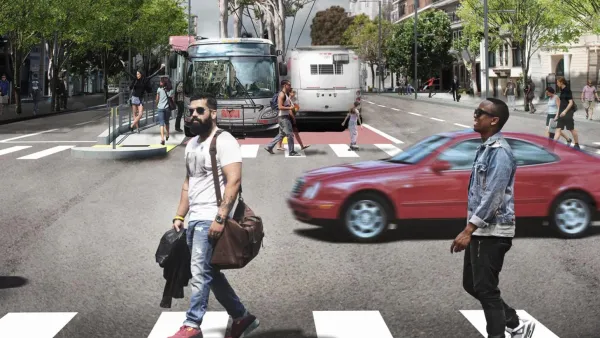The Van Ness Improvement project took almost two decades to cross the finish line, but it's almost there.

San Francisco has been working on the Van Ness Improvement Project, which includes the controversial addition of bus rapid transit lanes, for a decade and a half. Now a column by Carl Nolte reveals that the long haul is finally on the home stretch in a paywalled article for the San Francisco Chronicle.
First, here's how Nolte sums up the experience of planning, building, and waiting for the Van Ness Improvement project:
Van Ness has been torn up for the city to build an ambitious bus rapid transit corridor 2 miles long from Lombard to Mission streets. Two special lanes, just for buses, were built, along with landscaping, street trees and wider sidewalks. The project was designed to speed up local Muni buses and regional Golden Gate Transit service. It seemed like a great idea when it was in the planning stage. “When it’s done you’ll be thanking us,” Mayor London Breed said when she was president of the Board of Supervisors. But the work took forever. There were delays and cost overruns. It was the mess on Van Ness.
Nolte's exploration of the project includes a tour of the city that reaches back beyond the Roaring 20s, when Van Ness transitioned from the city's "grandest boulevard" to its auto row. Now new development is again transforming the buildings around Van Ness, punctuated by an ambitious rezoning and redevelopment effort at Van Ness and Market called The Hub.
Planetizen's coverage of the Van Ness Improvement project stretches back to 2006. A San Francisco Civil Grand Jury investigated the Van Ness Improvement project, asking where the project went wrong after winning funding from voters in 2003, but waiting until 2016 to break ground and then until about now to complete construction. A separate article by Kevin Truong reports the findings of the Grand Jury's investigation, providing a comprehensive account of the project's long history.
FULL STORY: The bandages are coming off: Check out S.F.’s new Van Ness Avenue

Analysis: Cybertruck Fatality Rate Far Exceeds That of Ford Pinto
The Tesla Cybertruck was recalled seven times last year.

National Parks Layoffs Will Cause Communities to Lose Billions
Thousands of essential park workers were laid off this week, just before the busy spring break season.

Retro-silient?: America’s First “Eco-burb,” The Woodlands Turns 50
A master-planned community north of Houston offers lessons on green infrastructure and resilient design, but falls short of its founder’s lofty affordability and walkability goals.

Test News Post 1
This is a summary

Analysis: Cybertruck Fatality Rate Far Exceeds That of Ford Pinto
The Tesla Cybertruck was recalled seven times last year.

Test News Headline 46
Test for the image on the front page.
Urban Design for Planners 1: Software Tools
This six-course series explores essential urban design concepts using open source software and equips planners with the tools they need to participate fully in the urban design process.
Planning for Universal Design
Learn the tools for implementing Universal Design in planning regulations.
EMC Planning Group, Inc.
Planetizen
Planetizen
Mpact (formerly Rail~Volution)
Great Falls Development Authority, Inc.
HUDs Office of Policy Development and Research
NYU Wagner Graduate School of Public Service



























